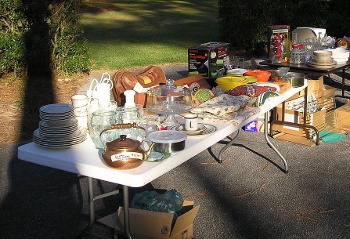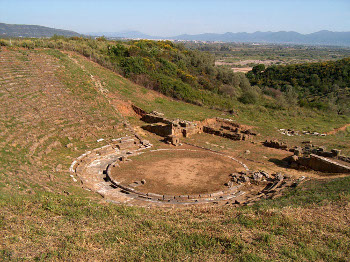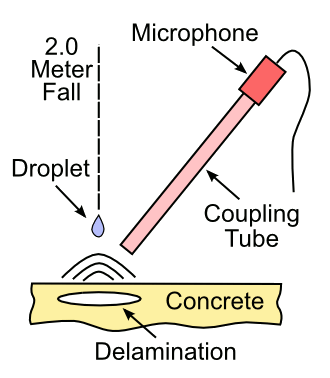Acoustic Evaluation
November 7, 2012
My mother and her sister were avid
yard sale shoppers. Yard sales are an entertaining use of your time, especially when you live in a populated area in which there are many such sales in close proximity every weekend. You rarely will find anything that you need, but you'll always find something that you want.
One common trick known to all yard sale shoppers is the ping test for
dinnerware and other ceramic pieces. That dinner plate or
figurine you're thinking about buying might look perfect, but it may have a small, invisible
crack that will cause the item to break after some handling or
thermal cycling. To test for such small cracks, you hold the
ceramic piece by an edge, and tap an edge with a
pencil. A nice
bell sound (ping) indicates a perfect piece, whereas a "clunk" indicates a crack.

OMG, how much for the plates!
The ping test, as described in the text, will tell you whether or not those dinner plates are worth the price.
(Yard sale photo via Wikimedia Commons)
Engineers have been using sound in the
non-destructive evaluation (NDE) of objects for quite some time. A few years ago, I proposed an acoustic real-time crack detection sensor for ceramic
body armor plates.
Ultrasonics are used to probe for cracks and voids in
welds. Acoustical methods have the advantage of being inexpensive. You can use
gamma rays from
Cobalt-60 to
image a weld, but imagine the cost,
safety, and
regulatory burdens.
The ping test is one method of acoustic evaluation, but when a system emits its own sounds, we can analyze those as well. I mentioned the analysis of
acoustic emission in two previous articles (
Acoustic Emission, March 11, 2011 and
Landslide Sensor, November 15, 2010 ). The first article reviews acoustic evaluation as it applies to the degradation of
machines; and the later describes acoustic signals as the harbinger of
landslides.
Scientific acoustic is most important in the design of
auditoriums. The problems of acoustics in enclosed spaces arise from all those
reflecting surfaces. A sound originating from the
stage will travel many different paths before reaching a listener's ear in the back rows, so the reconstructed signal will sound much different than the original signal. As if the physical structure of the auditorium wasn't problem enough, the presence of more or fewer people in the seats is another variable.
An interesting acoustic case history is
Lincoln Center's Avery Fisher Hall, which has had major problems with its acoustics, and
Herculean efforts to correct them. Since I've mentioned
Hercules, I'll add that the
ancient Greeks may have had the right idea of using open-air venues.

Greek theater at Stratos, Acarnania, Greece.
Stratos is somewhat distant from Athens, but it's possible that the plays of Aristophanes were performed here.
(Photo by Chris Makro, via Wikimedia Commons)
Acoustic evaluation can be applied in some interesting ways. An article in the
Journal of the Acoustical Society of America, which was always at the top of my routing list in the days when paper
journals actually passed hands, demonstrated that the sound of struck
volleyballs could be used as a
diagnostic tool for
coaches.[1] As an example of how
science builds on itself, this study used an analysis of the acoustic behavior of spiked volleyballs,
dribbled basketballs, and kicked
footballs, published a few years earlier.[2] The
resonant frequency of a volleyball is about 150
Hz.
There was an accelerated build-out of
infrastructure in the
US following
World War II that included such massive road projects as our
Interstate Highway System. You can't build something like a
bridge and then just ignore it. There's a need for constant
monitoring of its structural health; and also necessary follow-up
repair and maintenance, as
experience has shown.
There's considerable
research presently on embedding
sensor networks into bridges under construction to facilitate structural health monitoring. Such sensors will be a big help in the future, but what about existing structures? Bridges are actually monitored in a way similar to the dinnerware ping test described above, using a
hammer instead of a pencil; or, by dragging a
chain and listening for changes in sound. The
acoustic signature of a hammer impact on a bridge will tell you a lot about its structural health.
A team of engineers from
Brigham Young University (Provo, Utah), including
assistant professor,
Brian A. Mazzeo, and
associate professor Spencer Guthrie, has been investigating a more elegant technique of non-contact acoustic measurement of bridge deck inspection using
water droplets instead of hammers.[3-4] They're trying to develop a rapid measurement system that doesn't require
traffic lane closures to perform.
Says Brian A. Mazzeo, the corresponding author of a paper[4] describing this research in the journal,
NDT & E International,
"We would love to be able to drive over a bridge at 25 or 30 mph, spray it with water while we're driving and be able to detect all the structural flaws on the bridge."[3]
The measurement technique, as shown in the figure, involves the release of individual water droplets from a height (two
meters), detecting the sound produced with a
microphone, and analyzing the
sound spectrum. In their experiments, the sound was conducted by a tube to prevent damage to the microphone.

Inkscape)
The water drops are
accelerated by a two meter fall to increase their
velocity. This allows a greater
impact force, which generates a detectable sound at the microphone.[4] Water droplets of a uniform size were used in the experiments, since differently-sized drops will give different excitation forces.[4] The BYU team found that a
delamination in a
concrete plate has a fundamental resonance of about 1.5
kilohertz. Room noises were generally below a
kilohertz.
Deicing pellets can be used instead of water drops. These produce a good acoustic excitation, and they can be used in
freezing weather.[4] There may be applications for the water drop technique beyond bridge inspection. Mazzeo says that
aircraft composites, which can delaminate, might be tested this way.[3]
References:
- David G. Browning, "Sports acoustics: A simple acoustic method for player performance evaluation during volleyball games," J. Acoust. Soc. Am., vol. 106, no. 4 (Oct 1999), pp. 2292-2292.
- David G. Browning, Robert H. Mellen, Robert J. Schneck and Stephanie Milbradt, "Spiked volleyballs, dribbled basketballs, and kicked footballs: Excitation of the fundamental breathing mode in inflated sport balls," J. Acoust. Soc. Am., vol. 97, no. 5 (May 1995), pp. 3399-3399.
- Todd Hollingshead, "How highway bridges sing – or groan – in the rain to reveal their health," Brigham Young University Press Release, October 22, 2012.
- Brian A. Mazzeo, Anjali N. Patil and W. Spencer Guthrie, "Acoustic impact-echo investigation of concrete delaminations using liquid droplet excitation," NDT&E International, vol. 51 (October 2012), Pages 41-44.
Permanent Link to this article
Linked Keywords: Garage sale; yard sale; dinnerware; figurine; crack; thermal cycling; ceramic; pencil; bell; Wikimedia Commons; engineer; nondestructive testing; non-destructive evaluation; body armor; ultrasonic testing; weld; gamma ray; Cobalt-60; industrial radiography; safety; radiation Safety Officer; regulatory burden; acoustic emission; machine; landslide; scientific; auditorium; reflection; stage; Lincoln Center for the Performing Arts; Avery Fisher Hall; Herculean effort; Hercules; ancient Greece; ancient Greeks; Stratos; Acarnania; Greece; Athens; play; Aristophanes; Chris Makro; Journal of the Acoustical Society of America; scientific literature; scientific journal; volleyball; event correlation; diagnostic tool; coach; science; dribble; basketball; football; resonance; resonant; frequency; Hertz; Hz; infrastructure; United States; World War II; Interstate Highway System; bridge; structural health monitoring; repair and maintenance; bridge collapse in Minneapolis on August 1, 2007; research; sensor network; hammer; chain; acoustic signature; Brigham Young University (Provo, Utah); assistant professor; Brian A. Mazzeo; associate professor; Spencer Guthrie; water droplet; traffic lane; NDT & E International; meter; microphone; sound spectrum; gravitational acceleration; delamination; concrete; Inkscape; velocity; impact force; delamination; concrete; kilohertz; Deicing pellets; freezing; weather; aircraft; composite.